New Cannodale SuperSix EVO 4: Ultralight revolution
The new Cannondale Supersix EVO 4 is here, one of the most attractive bikes on the market takes another level with Ultralight weight and much-improved aerodynamics. Its revamp may appear to be a minor redesign, especially after the big leap it took with its total transformation in 2019 when it abandoned its classic bike look to move into the world of aerodynamics, but there's much more to it.
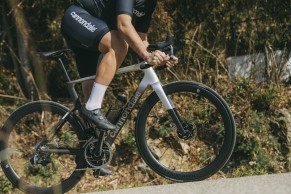
Cannondale SuperSix EVO 4: speed without compromise
When in 2019 Cannondale gave a total makeover to its SuperSix EVO, the brand's flagship road bike, we're not going to deny that we were a little disillusioned. That change meant giving in to the omnipresent relevance of aerodynamics and putting an end to what was one of the lightest, stiffest and most elegant bikes on the market, the last survivor among the big brands of traditional-looking bikes.
In any case, we must admit that the work done by Cannondale in this change was remarkable, achieving a bike with a very intuitive behavior and qualities in terms of feelings of stiffness and absorption capacity at the height of other reference bikes. However, it also had several downsides. Especially with regard to its atypical dashboard, cable routing and, especially, the weight toll paid for the introduction of aerodynamics and internal cable routing. Something very evident as soon as you left the top of the range models.
RECOMENDADO

When do helmets have to be changed? Do they have an expiration date?

The best apps for cycling and mountain biking

Black Friday 2025 cycling bargains: save on Garmin, POC, Maxxis and more

Black Friday Garmin 2025: the ultimate guide to choosing your GPS at the best price

Which profile wheels to choose according to the area where you live: mountain, flat or coast

How to wash your cycling clothes? 10 keys to make them always look new
A few weeks ago we traveled to Girona to see first hand the fourth generation of SuperSix EVO in the presentation in which the brand summoned the main media of the world cycling scene. A new bike without major external changes and which seeks precisely to address those weak points to achieve a much more complete and desirable product. A bike of which we had already seen many images of riders like Andrey Amador who have already been riding it and on which we were able to pedal on the Catalan roads.
Looking for the limit
This new Cannondale SuperSix EVO is, in addition to a new bike, the first creation of the new project of the American firm: the Lab71, which seeks to bring an extra level to all new models that are created by providing the rider with a much more careful product, with the most exquisite carbon or providing quality details from the most select components to bearings of the highest quality.
Incidentally, the name Lab71 refers to the year the brand was founded, recalling the small workshop where its creator, Joe Montgomery, worked hard to squeeze every gram and to push his creations to the limits of what bicycle manufacturing technology allowed at the time. The same philosophy with which this Lab71 is now born.
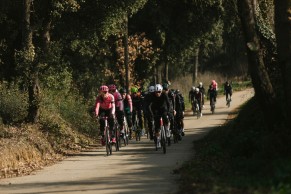
In the case of this generation 4 of the SuperSix EVO, this means first of all using a new type of carbon fiber called Series 0, which is complemented by the use of new nanoresins and a more elaborate laminate that allows to overcome the objectives of stiffness and absorption initially planned for this bike and therefore, it is not necessary to use so much material with which a significant improvement in the weight of the bike is achieved.
By the way, dynamic targets in which Cannondale has not sought greater stiffness or absorption as brands tend to promulgate. Continuous feedback from riders determined that both these values and the bike's behavior were already what they were looking for, so maintaining them with better material made it easy to cut grams.
The weight of the SuperSix EVO frame, painted and in size 56, is a fantastic 770g. For reference, the Hi-Mod and Carbon frames that complete this model's offering but use the raw materials that Cannondale has been using until now stop the scale at 810 and 930 g respectively. This means that its top-of-the-line Lab71 setup, with a Dura-Ace Di2 groupset, will set the scales at the 6.8 kg that the UCI sets as a minimum for a competition bike.
Improving what is present
The renovation of the SuperSix EVO has focused on several aspects. Firstly, the aforementioned weight, one of the Achilles heels of bikes in recent years, hampered by numerous factors such as the introduction of disc brakes, internal cable routing and the increasing importance of aerodynamics, which requires the use of more material to make up the different profiles of each frame tube.
In terms of aerodynamics, the work has mainly focused on finding new profiles and tube sections to improve the resistance figures of its direct rivals, but which, in turn, require less material to achieve the maximum possible reduction on the scales. A redesign that is especially evident in places like the slim head tube or the minimalist seat tube bottom bracket.

In addition to the bike, the quest for better wind penetration has involved work on the complete system, the concept that debuted on the previous SuperSix EVO and involved wheels, seatpost or cockpit created to work in concert with the rest of the frame.
That is why Cannondale has created for this bike new Hollowgram R50 wheels, available in SL and normal version with a weight of 1,520 and 1,620 g respectively for 50 mm profile rims and 21 mm internal width. They are different in the hub used: DT 240 for the SL and DT 350 for the conventional ones, and the spokes chosen.

These wheels are accompanied by a new set of aerodynamic integrated handlebars and stem called SystemBar R-One, with a design developed by the well-known automotive firm Momo Design, which gives this component a neat aesthetic in line with the rest of the bike.
Also with aerodynamics in mind are the new ReGrip Aero bottle cage and Gripper Aero bottle cage, which, on the diameter of a conventional bottle, in fact the bottle cage can accommodate any type of bottle, cuts the sides to leave them flat and thus reduce the front surface of the bottle without the need to widen the diagonal tube as we have seen in other designs that take into account this essential accessory.

The results in the form of numbers generated by the wind tunnel do not deceive: this 4th generation Cannondale SuperSix EVO outperforms both its predecessor and the System Six, the brand's specifically aerodynamic model. It also comes out ahead, according to Cannondale's own data in this aspect with respect to bikes like the Trek Émonda or the Specialized Tarmac SL7.
Working out the details
We mentioned earlier the slim head tube that Cannondale has achieved on this bike, which does its bit to reduce wind resistance. A slender shape that is made possible by the new fork, which is fitted with a steerer tube called Delta.
As you can imagine, this tube is not cylindrical but has an almost triangular section with the side pointing towards the rider maintaining an arc to provide sufficient bearing surface on the steering bearings and the remaining two sides ending in a point so that there is a gap between the bearing and the steering tube to allow the cables to pass through.

Another interesting design feature is the location chosen for the battery in the case of a Shimano Di2 groupset. Cannondale has created an in-mold housing along the down tube next to the bottom bracket that is easily accessed through a small cover. This arrangement makes it easy to remove the seatpost, for example when we travel with the bike and have to fit it in a specific case, an aspect that is also helped by a detail such as the wedge that fixes it to the frame, which remains attached to it.
We find changes in this SuperSix EVO with respect to its predecessor in the thru-bolts of the wheels, renouncing the Mavic Speed Release system that did not incorporate the previous one, becoming these conventional. By the way, the blind thread on the right fork leg is very elegant.

The real revolution of this bike, however, is the brand's decision to abandon the bottom bracket system chosen. Cannondale has abandoned its BB30, the oversized bottom bracket system it introduced several decades ago, and opted for traditional BSA threaded cups, a difficult decision but one made under pressure from the major component manufacturers who want to see their groupsets fully displayed on the bikes, especially on the bottom bracket, one of the places that first catches the eye.
In any case, this change, for practical purposes, is an improvement in terms of ease of maintenance, although it raises the question of what will happen to the Hollowgram cranks that the brand has been mounting on its bikes. During the presentation they did not know or could not give us the answer to this question but, for the time being, the setups presented mounted the cranks corresponding to their respective groupsets.

A bike that, without major external changes, does mean rounding off a tremendously attractive model and that has already given the brand a few joys with victories, both in the final part of the 2022 season and at the beginning of this season by the cyclists from EF Education-EasyPost and EF Education-TIBCO SV.
Cannondale SuperSix EVO: Setups and prices
SuperSix EVO Lab71 - 14,999 €
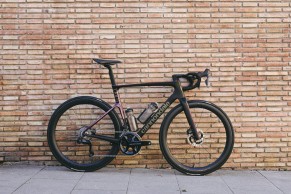
- Price: 14,999 €
- Frame/fork: LAB71 SuperSix EVO, Ultralight Series 0 Carbon
- Groupset: Shimano Dura-Ace Di2, 52/36 cranks, 11-30 cassette
- Wheels: HollowGram 50 R-SL
- Tyres: Continental GP5000, 700x25
- Handlebar/stem: Cannondale SystemBar R-One
- Seat post: Cannondale C1 Aero 40 Carbon
- Saddle: Fi’zi:k Vento Argo 00 Carbon
- Sizes: 44, 48, 51, 54, 56, 58, 61
SuperSix EVO Hi-Mod 1 - 13,499 €
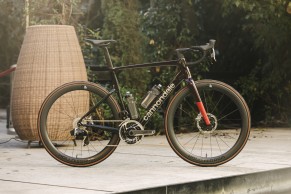
- Price: 13,499 €
- Frame/fork: SuperSix EVO Hi-MOD Carbon
- Groupset: SRAM Red eTap AXS. 48/35 cranks, 10-28 casette
- Wheels: HollowGram 50 R-SL
- Tyres: Continental GP5000, 700x25
- Handlebar/stem: Cannondale SystemBar R-One
- Seat post: Cannondale C1 Aero 40 Carbon
- Saddle: Prologo Dimension NACK NDR
- Sizes: 44, 48, 51, 54, 56, 58, 61
SuperSix EVO Hi-Mod 2 - 8,999 €
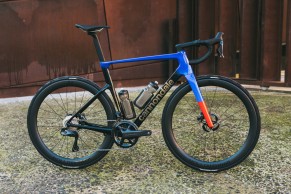
- Price: 8,999 €
- Frame/fork: SuperSix EVO Hi-MOD Carbon
- Groupset: Shimano Ultegra Di2. 52/36 cranks, 11-30 casette
- Wheels: HollowGram 50 R-SL
- Tyres: Continental GP5000, 700x25
- Handlebar: Vision Trimax Carbon Aero
- Stem: Cannondale C1 Conceal, aluminum
- Seat post: Cannondale C1 Aero 40 Carbon
- Saddle: Prologo Dimension TiRox NDR
- Sizes: 44, 48, 51, 54, 56, 58, 61
SuperSix EVO Carbon 1 - 6,999 €
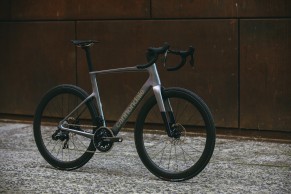
- Price: 6,999 €
- Frame/fork: SuperSix EVO Carbon
- Groupset: SRAM Force eTap AXS. 48/25 cranks, 10-33 casette
- Wheels: HollowGram 50 R-S
- Tyres: Vittoria Rubino Pro Bright Black, 700 x 25c
- Handlebar: Vision Trimax Carbon Aero
- Stem: Cannondale C1 Conceal, aluminum
- Seat post: Cannondale C1 Aero 40 Carbon
- Saddle: Prologo Dimension TiRox NDR
- Sizes: 44, 48, 51, 54, 56, 58, 61
SuperSix EVO Carbon 2 - 6,799 €
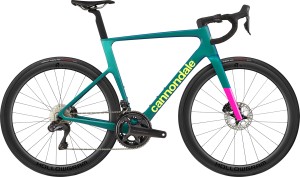
- Price: 6,799 €
- Frame/fork: SuperSix EVO Carbon
- Groupset: Shimano Ultegra Di2. 52/36 cranks, 11-30 casette
- Wheels: HollowGram 50 R-S
- Tyres: Vittoria Rubino Pro Bright Black, 700 x 25c
- Handlebar: Vision Trimax Carbon Aero
- Stem: Cannondale C1 Conceal, aluminum
- Seat post: Cannondale C1 Aero 40 Carbon
- Saddle: Prologo Dimension STN NDR
- Sizes: 44, 48, 51, 54, 56, 58, 61
Frame Kit SuperSix EVO Lab71 - 5,499 €
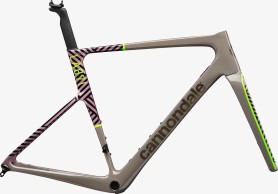
- Price: 5,499 €
- Frame/fork: LAB71 SuperSix EVO, Ultralight Series 0 Carbon
- Seat post: Cannondale C1 Aero 40 Carbon
- Sizes: 44, 48, 51, 54, 56, 58, 61
Frame Kit SuperSix EVO Hi-Mod - 4,199 €
- Price: 4,199 €
- Frame/fork: SuperSix EVO Hi-MOD Carbon
- Seat post: Cannondale C1 Aero 40 Carbon
- Sizes: 44, 48, 51, 54, 56, 58, 61
Further information available on the Cannondale website.